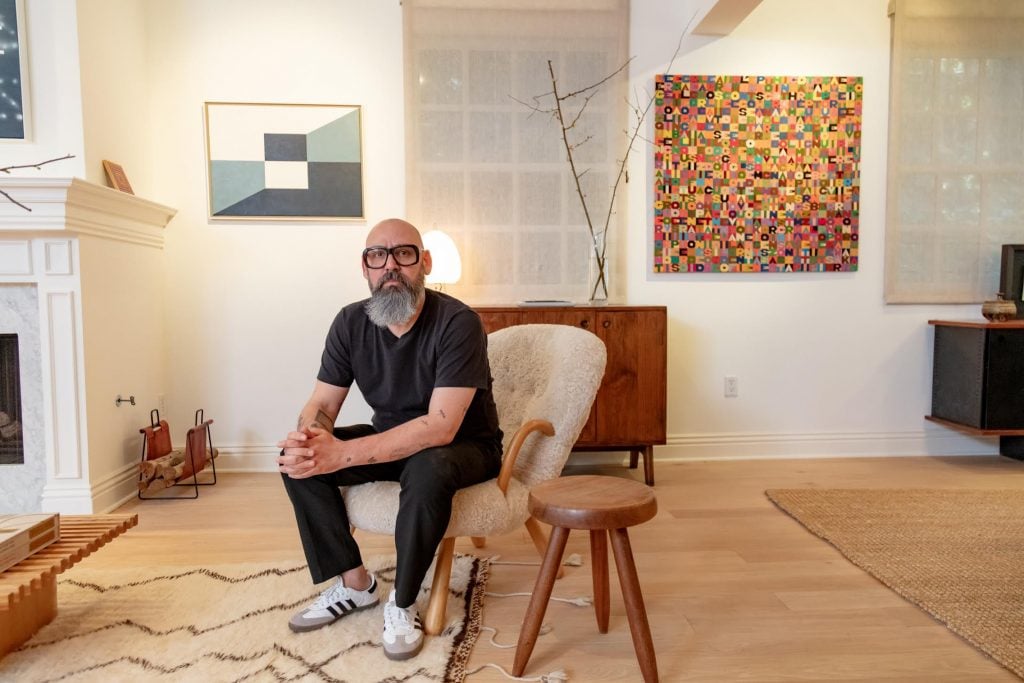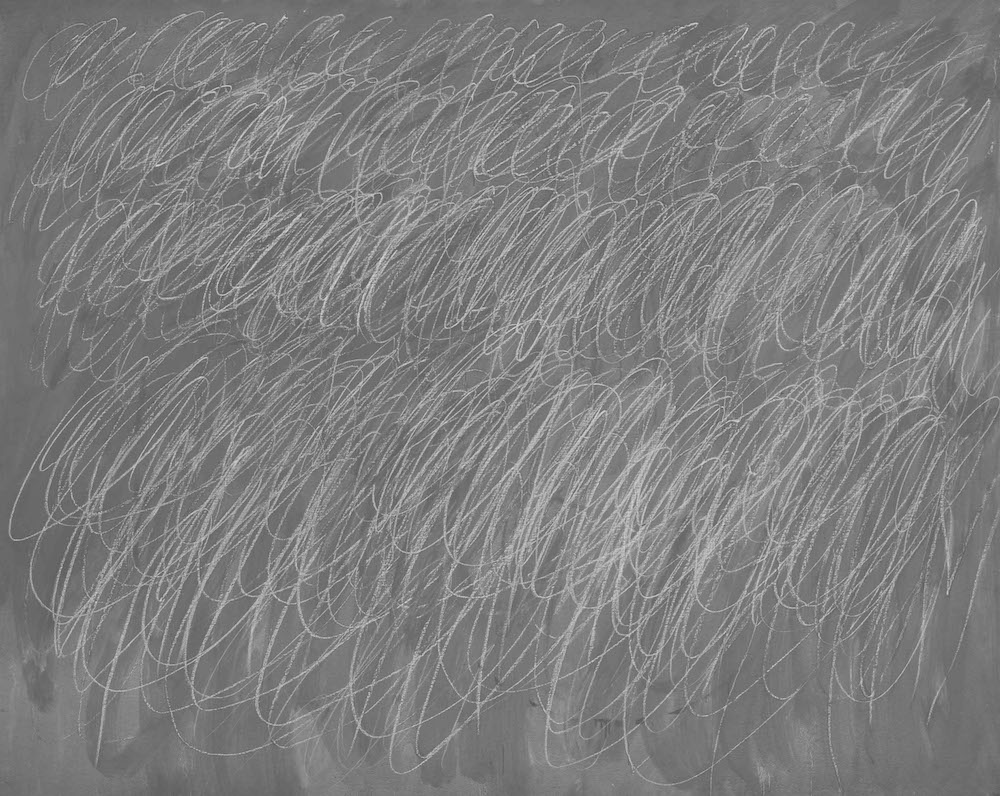Art Collectors
What I Buy and Why: Pulse Music Group Founder Josh Abraham Has an On Kawara of His Birthday Date
The L.A. collector explains what makes his Ed Ruscha so personal, and the Günther Förg that got away.

The L.A. collector explains what makes his Ed Ruscha so personal, and the Günther Förg that got away.

Artnet News

For Josh Abraham, music and art are inextricably linked. His recent involvement as an organizer for LACMA’s “Artists Inspired By Music: Interscope Reimagined” solidified him as a mover and shaker in Southern California’s art scene—and he’s got the Ed Ruscha with his own music label’s name on it to prove it.
Ahead of Frieze Los Angeles, another big moment for the city’s art scene, we sat down with Abraham to hear a bit more about his journey as a collector who also has an ear to the ground for music.
What was your first purchase (and how much did you pay for it)?
Back in early 2001, Blum & Poe was this postage-stamp sized gallery in an office park in Santa Monica. On instinct I bought a Yoshitomo Nara for $35,000 which was a record price for him at the time. It was a lucky start out of the gate.
What was your most recent purchase?
I have a particular passion for Italian modern artists like Lucio Fontana and members of Arte Povera like Jannis Kounelis and the Swiss artist Olivier Mosset. My most recent purchase is a larger scale “Arazzi” work by Alighiero Boetti. The multi-faceted, multi-artist nature of Alighiero Boetti’s practice is fascinating to me—for Boetti, much like producing music, it takes a village, in his case it literally took a village. The “Arazzi” series are amazing embroidered pieces made in a collaborative effort with Afghani and Pakistani artisans.
Which works or artists are you hoping to add to your collection this year?
I am a huge Josef Albers fan and think his importance in modern art and ultimately contemporary art can’t be stressed enough. I try and collect an artist in-depth when possible and I am lucky to live with an Homage to the Square, his most famous series, however I would love to add one of his “Adobe” works to my collection. His thoughts on color theory and abstraction have allowed me to see this connection between all artists and has paved the way for many contemporary artists. Strangely enough, this has led me to look deeper at the works of Reggie Burrows Hodges, who also uses color and abstraction to tell his story. At first glance you wouldn’t think so, but these are two artists are using the same language to express their ideas.
What is the most expensive work of art that you own?
I don’t keep a scorecard on value for each individual work, I look at the collection as a whole… but I have an Ed Ruscha “Mountain” painting that says “DOWNTOWN” that my insurance company charges a high premium for.
Where do you buy art most frequently?
My relationships in the art world, just like my relationships in the music business, are heavily personality driven. I have made some of my best friends connecting over discussing the work of my favorite artists, bonding over collecting, doing studio visits, and traveling to art fairs—this has informed a lot of what I collect and from whom. I have been fortunate to establish relationships with people in the art world who have a finger on this specific kind of creativity. I recognize them like I do with people I work with in music.
What started as a hobby has turned into a deep passion that drives me on a daily basis. Because of galleries like David Kordansky, Karma, and Various Small Fires, I have been exposed to some really great artists. This has allowed me the opportunity to collect the artists I am most passionate about. Massimo de Carlo, my favorite gallery in Milan, was instrumental in getting the Boetti, while Gagosian has supported my collection in too many ways to say.

Josh Abraham, CEO and founder of Pulse Music Group. Courtesy of Pulse.
Is there a work you regret purchasing?
The journey is long and as a collector you are constantly evolving, shaping and learning as you go. My collecting started out as impulse purchasing and now it’s all intuition—but it took time.
On the music production side, it’s not that much different. I would keep going until I had the right song and when it would come out and connect, that’s when I started to trust myself. It’s about trusting your gut and having the confidence to know when to stop a song from going the other way or when to not pass on a great painting. Having regrets keeps us measured when making decisions.
What work do you have hanging above your sofa?
In one room I have a salon-style wall of Raymond Pettibon drawings that I bought from Regen Gallery in the early 2000s, and in another room an Ed Ruscha “City Lights” painting that says “PULSE,” which is an homage to the music company I co-founded.
What about in your bathroom?
Right now I have an On Kawara “I Got Up” series which also happens to be my birthdate. It was pretty cool because I wasn’t even looking for it, it just found me. It’s pretty rare to find your birthday!
What is the most impractical work of art you own?
Impractical isn’t the way I look at it, but I will say my Ugo Rondinone “Human Nature” sculpture isn’t the easiest to move. Made for outdoors and made of bluestone, concrete, and steel, I love this sculpture and decided to place it indoors. It certainly dictates the hang in that area of the house!
What work do you wish you had bought when you had the chance?
I think every collector could probably rattle off a list and I am no exception to the rule. I would have to say a Günther Förg “Back and Forth” painting. Inspired by a photograph of the inside of Francis Bacon’s studio, these paintings are both beautiful and conceptual at the same time, a theme that seems to run through my collection. There was one with a certain color palette I didn’t understand when I first saw it but I would only choose that one today.
I also have a friend who had parents that ran a gallery in L.A. and showed Basquiat. He used to have late night parties in the ’90s and the works would just be leaning on the wall and he used to offer them out for next to nothing while everyone partied around them.

Cy Twombly Rome (1972). Image courtesy Sotheby’s.
If you could steal one work of art without getting caught, what would it be?
A Cy Twombly “Blackboard” would be nice.